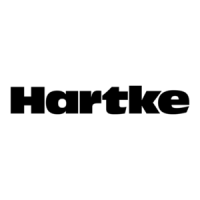Guided Tour - HA3000 Front Panel
1. Inputs - Connect your bass guitar to one of these standard 1/4" unbalanced jacks.
If your bass has passive electronics (that is, if it has no battery), connect it to Input 1, which
is designed to handle low-level signals. If your bass has active electronics (that is, if it has
a battery), connect it to Input 2, which employs a 10 dB pad and is designed to handle
hotter bass pickup signals.
2. Volume control - This is the overall volume control. For best signal-to-noise ratio, keep
the output of your bass at or near maximum and set the HA3000 Volume to the desired
level.
3. Shape control - In conjunction with the Intensity control (see #4 below), this control
applies a specialized 20 dB notch filter to the specified frequency area so that you can
customize the effect of the Shape curve to best complement your particular bass
instrument. Moving the Shape control clockwise causes the notch filter to be applied to
higher frequencies, while moving it counterclockwise causes it to be applied to lower
frequencies. At the fully clockwise position, the filter is applied to the 1 kHz frequency
area; this will act to attenuate mid-range frequencies and give your bass a deep, low tone.
At the fully counterclockwise position, the filter is applied to the 90 Hz frequency area; this
will act to attenuate low frequencies and give your bass a biting, trebly sound. For more
information, see the “Using Equalization and Shape” section on page 11 in this manual.
4. Intensity control - Determines the degree to which the Shape curve (set with the
Shape control; see #3 above) affects the signal; the higher the Intensity, the greater the
effect of the notch filter. When set to 0, the Shape curve has no effect.
5. EQ controls - These four controls provides approximately 15 dB of cut or boost at each
of four frequency areas: 80 Hz (Low), 220 Hz (Low Mid), 770 Hz (High Mid), and 5 kHz
(High). When the equivalent knob is at the 12 o’clock (“0”) position, there is no boost or
attenuation (flat response). As it is turned clockwise from the “0” position, the
corresponding frequency area is boosted; as it is turned counterclockwise from the “0”
position, the corresponding frequency area is attenuated. For more information, see the
“Using Equalization and Shape” section on page 11 in this manual.
6. Direct Out - This standard balanced XLR jack provides an instrument-level output
signal which is pre-EQ, pre-Shape and pre-Volume. This is generally used to send “dry”
signal from the HA3000 to a PA system or recording mixing console.
7. Status LEDs - The bottom “Power” LED lights whenever the HA3000 is powered on
(see #8 below). The top “Clip” LED lights whenever the output signal rises to an
unacceptably high distortion level. The center “Protection” LED goes on for approximately
five seconds when the HA3000 is powered on and fades slowly when it is powered off.
While it is lit, all connected speakers are muted via mechanical relay, thus preventing any
“thump” from occurring.
8. Power switch - Use this to power the HA3000 on or off.
5

